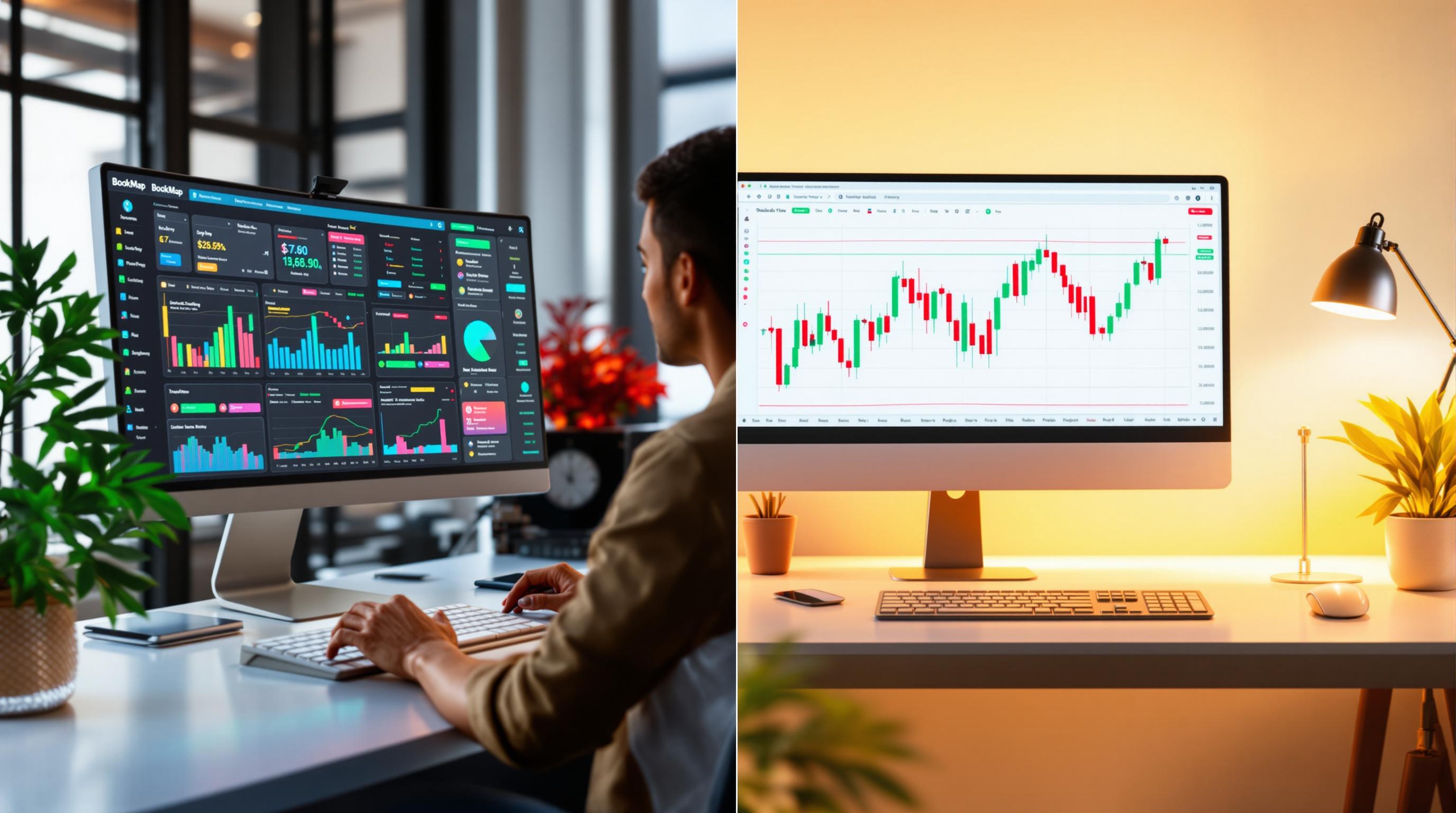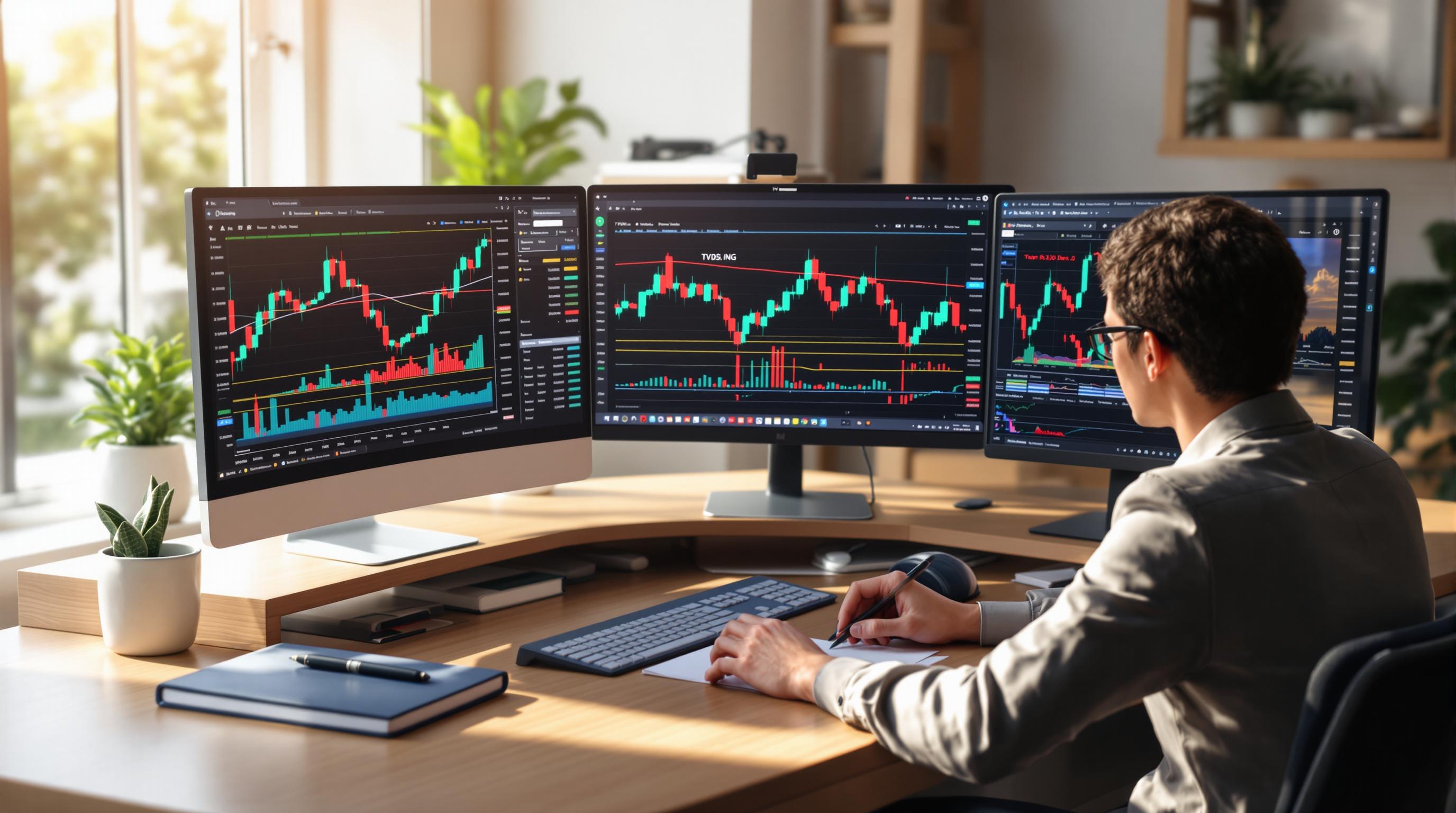Which is better for stock screening: mobile apps or desktop tools? It depends on your trading style and needs. Mobile apps are great for quick, on-the-go monitoring and trades, while desktop platforms excel in detailed analysis and multitasking. Here's the breakdown:
- Mobile apps prioritize simplicity, portability, and real-time alerts. They're ideal for casual investors or quick decisions.
- Desktop tools offer advanced features like multi-monitor setups, complex charting, and faster data processing, making them perfect for in-depth analysis and professional trading.
Quick Comparison:
| Feature | Mobile Apps | Desktop Tools |
|---|---|---|
| Portability | Excellent for on-the-go use | Limited to workstation |
| Screen Size | Small, single-view interface | Large, multi-panel, multi-monitor setups |
| Charting Tools | Basic indicators (e.g., RSI, MACD) | Advanced indicators and customization |
| Order Types | Simple market orders | Complex orders (e.g., bracket, conditional) |
| Performance | May experience delays (cloud-based) | Faster, local data processing |
Key Takeaway:
Use mobile apps for quick monitoring and trades, and desktop platforms for detailed research and strategy execution. Combining both can maximize your efficiency.
Which Is Better? (Desktop vs Mobile Stock Trading)
Usability and Access
How you interact with stock screeners varies significantly between mobile and desktop platforms. Each approach comes with its own strengths, designed to enhance your screening experience in different ways.
Interface Design and Navigation
Mobile stock screeners are built with simplicity in mind, focusing on essential features due to limited screen space. They typically use a vertical scrolling format, allowing you to focus on one piece of information at a time. On the other hand, desktop platforms leverage larger screens to display multiple panels simultaneously, spreading information both vertically and horizontally. This setup lets you view stock lists, charts, and filtering tools all at once without needing to switch between screens.
Navigation also differs greatly. Desktop platforms rely on features like hovering, multi-level menus, and keyboard shortcuts for quick access. For instance, you can use right-click menus or keyboard combinations to filter stocks efficiently. Mobile navigation, however, is centered around gestures like swiping and tapping. While these gestures feel intuitive on touchscreens, they often require moving between several screens to complete tasks that desktops can handle in a single view.
Portable Access vs. Stable Workspace
Mobile stock screeners shine when speed and portability matter most. For example, Stock Rover's mobile app offers over 150 metrics for filtering stocks, showing that mobile platforms can handle complex tasks. The real advantage lies in their ability to alert you instantly about market opportunities, no matter where you are. With push notifications, your mobile device essentially becomes a real-time market monitor.
In contrast, desktop platforms provide a stable and powerful environment for in-depth analysis. They avoid common mobile limitations like battery life concerns and small display sizes, making them ideal for more detailed evaluations.
Screen Size Limits and Multi-Monitor Setup
The smaller screens of mobile devices naturally limit the amount of visible data, often requiring you to switch between views to gather all the information you need. Desktops, especially those with multi-monitor setups, allow for simultaneous analysis of multiple data points, making it easier to compare and evaluate stocks side by side.
Desktop platforms often use features like hover actions or expandable menus to maximize screen space and display additional data only when needed. In contrast, mobile platforms rely on scrolling to reveal information. While scrolling works well for reviewing data in sequence, it can make comparing multiple data points more difficult, as the context may get lost.
Ultimately, these differences highlight how each platform caters to specific trading needs. Mobile screeners are perfect for quick, on-the-go decisions, while desktop platforms provide the comprehensive tools necessary for deeper, more thorough analysis.
Feature Comparison
The features available on mobile and desktop stock screeners vary widely, with each platform catering to different trading styles and user needs. These distinctions make it easier to decide which platform aligns better with the complexity of your trading strategy.
Charts and Technical Indicators
Desktop platforms are built for depth and precision, offering advanced charting tools, a wide range of technical indicators, and custom drawing capabilities. They allow for intricate scans that mobile apps simply can't match due to screen size and processing limitations. For example, TC2000 shines with its integrated trading features and formula-writing tools, enabling traders to create highly specific scans tailored to their strategies.
Mobile charting, on the other hand, focuses on the basics. You'll find essential indicators like moving averages, RSI, and MACD presented in a simplified format designed for smaller screens. While mobile charts are convenient for quick checks, desktop platforms take the lead when it comes to in-depth analysis. Plus, desktop software processes data locally, ensuring faster updates and smoother performance, whereas mobile apps rely on cloud processing, which can result in delays during high trading activity.
Order Execution and Alerts
Mobile platforms are all about speed and convenience. With push notifications, you can stay informed of critical market moves even when you're on the go. The touch-based interface makes executing simple market orders fast and straightforward, perfect for traders needing quick reactions.
Desktop platforms, however, provide a more sophisticated experience. They support complex order types like bracket orders, conditional orders, and algorithmic strategies, which are easier to set up and monitor on a larger screen. The detailed order management interfaces on desktops allow for a level of control that's hard to achieve on mobile. And while mobile alerts are great for immediate updates, desktop alerts often include extra context, such as charts or news, giving you a fuller picture of the situation.
Layout Options and Workspace Setup
When it comes to customization and workspace flexibility, desktop platforms are in a league of their own. For instance, Interactive Brokers offers a "My Layouts" feature, allowing users to design personalized pages. Tools from the Custom Layout Toolbox can be organized by Quote, Trade, and Information tabs, and users can move, resize, and synchronize these tools with a color grouping feature. This ensures that all related tiles update in unison when a new symbol is entered.
Similarly, TradingView's professional plans let users display up to 8 charts per layout and choose from 12 grid options, making it easy to optimize multi-monitor setups for maximum efficiency.
Another major advantage of desktop platforms is multi-monitor support. This feature enables traders to view charts, screeners, and news feeds simultaneously across multiple screens, creating a dynamic and comprehensive trading environment. Mobile devices, with their single small screen, simply can't replicate this level of multitasking.
sbb-itb-2e26d5a
Performance and Reliability
When it comes to performance, mobile and desktop screeners show clear differences. Desktop screeners often deliver quicker and more stable real-time data compared to their mobile counterparts.
Data Speed and Response Time
Mobile platforms can experience delays due to network or device constraints, though some apps are designed to handle this effectively. Take MOMO Pro as an example - it processes real-time data with a latency of less than 10–20 milliseconds. Even during heavy trading periods, the platform manages data by queuing it to ensure clarity. While this introduces a minor delay, the overall performance remains impressively fast.
On the other hand, desktop tools have the advantage of processing data locally, which allows for even quicker updates during high-activity trading sessions.
Choosing the Right Tool for Your Needs
Picking the right stock screening tool boils down to understanding your trading style and specific requirements. In many cases, traders find it effective to use a combination of tools strategically.
Match Tools to Your Trading Style
Your trading style plays a big role in determining which tools will work best for you. Each style has unique demands, and the right platform can make all the difference.
Day traders often lean toward desktop platforms. Why? They need real-time data, advanced charting tools, and the ability to monitor multiple screens simultaneously. These features are crucial for making quick, informed decisions. Mobile apps, while not the primary tool, can act as a handy backup for checking positions when you're away from your desk.
Swing traders, with their focus on medium-term price movements, enjoy more flexibility. Both desktop and mobile platforms offer the historical data and technical indicators they rely on. While desktops provide more robust tools for in-depth analysis, mobile apps shine in their convenience, allowing traders to keep tabs on positions and make adjustments on the go.
Long-term investors typically find mobile apps sufficient. Since they execute fewer trades, the portability and simplicity of mobile platforms align well with their needs. These apps allow investors to monitor portfolios, perform basic research, and place occasional trades without needing the extensive features of a desktop setup.
Mobile vs. Desktop: When to Use Each
Both mobile apps and desktop platforms have their strengths, and knowing when to use each can optimize your trading experience.
Mobile apps are perfect for situations where speed and portability are essential. They're great for quick trades, responding to market alerts, and checking your portfolio on the fly.
Desktop platforms are more suited for in-depth tasks. They provide a stable environment for detailed technical analysis, managing multiple stocks at once, and executing complex strategies that require precision and up-to-the-minute data.
Use mobile apps for:
- Trading or monitoring while traveling
- Quick responses to market alerts
- Checking your portfolio during downtime
- Making simple trades or adjustments
Use desktop platforms for:
- Conducting detailed technical analysis
- Managing multiple stocks simultaneously
- Executing intricate trading strategies
- Accessing the most accurate, real-time data
Selecting the Right Tools
Once you've identified how and when you'll use each platform, the next step is choosing tools that enhance your trading strategy.
Focus on features that align with your needs, whether it's real-time data, advanced charting, historical analysis, or customizable alerts. The user interface is another critical factor - your tools should fit seamlessly into your workflow.
For instance, TradingView boasts over 90 million active users worldwide, highlighting the demand for tools that combine functionality with ease of use. To dive deeper, the Best Investing Tools Directory offers detailed reviews and comparisons of stock screening tools, charting platforms, and technical analysis software. This resource can help you make informed decisions tailored to your trading goals.
Many traders find that a hybrid approach works best - using desktops for in-depth analysis and mobile apps for monitoring and quick adjustments on the go.
Conclusion
Choosing between mobile stock screeners and desktop tools ultimately comes down to your trading style and daily workflow.
Desktop platforms offer powerful features, delivering fast, locally processed data and providing a stable environment for in-depth analysis and multitasking. They even allow offline access, making them a solid choice for those who need a comprehensive research setup. On the other hand, mobile apps focus on core functions, offering convenience with real-time alerts and market access wherever you are. Their simple interface is perfect for quick market updates, though they might not handle heavy filtering or extended use as efficiently.
For many traders, combining the two works best. Using desktop tools for detailed research and analysis while relying on mobile apps for quick monitoring and trade execution lets you make the most of both platforms. This way, you can adapt to the strengths of each tool and stay connected to the market at all times.
Check out the Best Investing Tools Directory for expert reviews to help you find the stock screening solution that fits your needs.
FAQs
What’s the best way to combine mobile stock screeners and desktop tools to improve my trading strategy?
To maximize your trading strategy, consider pairing mobile stock screeners with desktop tools, taking advantage of what each does best. Mobile apps keep you connected to the market no matter where you are, delivering real-time updates, alerts, and the ability to make quick decisions on the fly. On the other hand, desktop platforms shine when it comes to advanced features like detailed charting, thorough analysis, and customizable screening options.
By combining the two, you can stay on top of market movements with your mobile device and dive into deeper analysis on your desktop when needed. This blend of tools allows you to act quickly on opportunities while ensuring your decisions are backed by in-depth research, ultimately improving your trading efficiency and precision.
What features should I focus on when deciding between mobile and desktop stock screening tools?
When weighing your options between mobile and desktop stock screening tools, think about how you’ll use them in your investing routine.
Desktop platforms shine when it comes to detailed analysis. They typically offer advanced features like robust charting tools, multiple technical indicators, and real-time data streaming. Plus, the larger screen size and higher processing power make them ideal for multitasking and digging deep into research.
On the flip side, mobile platforms are all about convenience. They’re built for speed, with user-friendly interfaces, instant notifications, and quick scanning capabilities - perfect for making decisions while you're on the move.
The right choice depends on your investing style: go with desktop tools for thorough, in-depth analysis or mobile tools for their flexibility and speed.
What are the limitations of using mobile stock screeners for long-term investing?
Mobile stock screeners often fall short for long-term investing because they tend to emphasize short-term metrics like beta or recent price trends. While these metrics are helpful for quick decisions, they don’t necessarily shed light on a stock’s long-term growth potential. As a result, it can be difficult to assess critical factors like steady earnings growth or a company’s competitive edge using these tools.
Another limitation is the smaller screen size and streamlined interfaces of mobile apps. These features, while convenient, can make it harder to dive into detailed research or compare multiple data points side by side. For a long-term investment approach, you’ll likely need more advanced tools that provide in-depth, forward-looking analysis to pinpoint opportunities with lasting growth potential.



